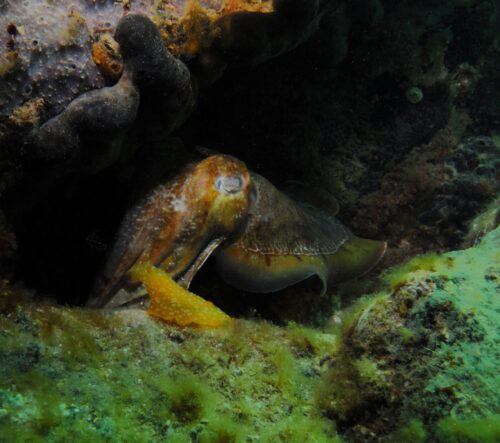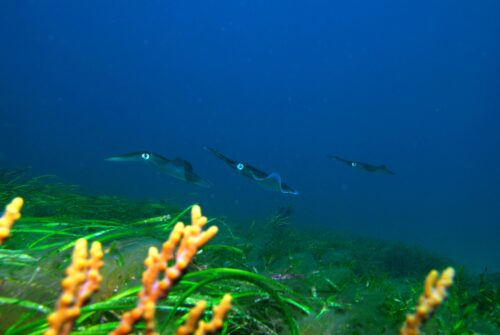These are the notes prepared for the presentation given by Chris Iwanicki, David Muirhead and Steve Reynolds at our September General Meeting. There would have been some ad-libbing and questions on the night, but these notes provide the main details of the presentation.
Steve started proceedings by reading:
“Australian Ocean Laboratories (AusOcean) recently reported details of squid apparently trying to mate with cuttlefish at Stony Point, Whyalla (Stony Point CuttleCam by AusOcean 12/07/2023).

(The full YouTube footage can be seen at https://www.youtube.com/clip/Ugkxemtbhd6Jt7gxhUjkIZVBXio3kngnnQPi?fbclid=IwAR3Buz30oI3GTdd WQiiNrU17sqx2fhedUnkfmDMk3c8qpXGOwgcNWr2KJLI .)
AusOcean posed the questions, “Has anyone seen an interaction with squid/cuttlefish like this before? Is the squid trying to mate with the cuttlefish?”.
I reported the matter in the August newsletter of the Scuba Divers Federation of South Australia. That led to some discussion between Chris Iwanicki, David Muirhead and me.

(Photo taken by David Muirhead)
Chris led the conversation when he sent the following email to David & I: -“
Chris then read out the details of the email that he had sent to David & Steve:
“Hi Steve and David,
I had a look at the footage too. I can’t help thinking the squid might be actually laying eggs close to the camera mounting frame (weed growth on this frame??), out of shot of the camera. There might be some other footage showing squid eggs around this time from a tourist given the squid eggs would remain for some time (8 weeks??) and the camera itself acting as an object of photo interest? The squid behaviour (excluding the cuttlefish) seems to me identical to footage I have of squid laying eggs, except the actual egg placement here is out of shot. When I have seen eggs laid by squid (only 3 times) they become quite one minded and, with a bit of care, not easily disturbed. As possibly having to share the immediate area with cuttlefish also, maybe it is just a bit of overlap, as a single cuttlefish (as opposed to an actively competing group) which may be just inspecting/guarding a den, etc. (e.g. incl. approaching end of life) and is not reacting to the squid aggressively, can see how co-existence might be acceptable. As the egg laying sites are very different for both, and do not impede on each other, maybe it is a co-incidence. Amazing footage regardless. Maybe Dr Roger Hanlon would have some clearer idea, thinking he would be interested in seeing the footage. Cheers, Chris”
David then read out his response to Chris’ email:
“Chris, I like your rationale for coincidence as a good explanation. Very well thought out response. So many variables involved; you’ve added some that I hadn’t even considered, especially the possibility that weed on camera could exclude vision of actual egg laying by a squid. I’ve never seen a squid laying eggs, which puts me on the back foot here. ….. The different site choices for egg attachment between the two cephalopods is another good point you raise. Another thought: might squid be so intelligent that despite their short lives they actually play games? Like having fun imitating other marine animals? After all, dolphins do.”
Chris then read out part of his reply to David:
“The other thought is like what you mentioned in that the cuttlefish shadowed by the squid could be (if they were laying eggs) in their fixed mind assumed the similarities of the cuttlefish shape as another squid? Think I may have shown you the footage one time at MLSSA meeting but can dig it out for another look if you are interested or have not seen it, the colourations and behaviour (are) strikingly similar.”
Chris then showed us all some of his video footage, during which he read out some of what he had written to Steve:
“I got a really great response from Prof. Roger Hanlon with great information about the squid/cuttlefish footage ….. Basically, from what I understand from his email, there is definitely no actual interaction between the cuttlefish and the squid (Sepioteuthis australis, aka the Southern Calamari). He goes on to explain that there is a female squid above the cuttlefish in the frame in the footage, but they are not interacting as such. What then happens, partly out of frame, is a male squid approaches the female mentioned, and then flips upside down to pass on spermatophores to her. Unfortunately, this is not completely seen, but you can see the male turning upside down at the edge of frame. The Flinders Uni PhD study conducted at Marino Rocks (“Reproductive Behavior in the Squid Sepioteuthis australis From South Australia: Interactions on the Spawning Grounds” by Troy M Jantzen and Jon N Havenhand 2003) found there are four mating styles for the squid at the Marino: About 64% of squid mate, i.e. pass on spermatophores, by turning upside down and make contact, known as “Male-upturned mating” (as seen in the Cuttlecam footage from Stony Point); less common is “Sneaker mating” (33%); “Male-parallel” (2%); and “Head-to-head” (1%). There is also the inference with comparison to studies these behaviours may vary with squid populations (Sepioteuthis australis) in different areas.
What occurred to me is that, although I have been lucky enough to get footage of squid laying eggs more than once, I have yet to witness any of the above-described mating behaviours. The PhD study (Troy et. al.) found that while squid are engaged in mating behaviour, they can be approached to very close by, the same as I have found with egg laying. It would seem that mating would have been happening while I am taking footage of egg laying, but I have missed this, and I’m guessing that going down with a breath of air and no wet suit has its limitations.
It is a real shame that Marino is now opened up to spearfishing, which will undoubtedly have substantial and sustained negative consequences for the local squid populations breeding cycle. This area represents the northward extent of the Gulf’s coastal based rocky shore/reef system which supports extensive wire weed and seagrass habitats and is an important nursery environment for multiple species. At this site I have seen larger numbers (aggregations?) of squid than any other Metro Adelaide site. Marino has long been popular with Adelaide’s recreational boat and shore-based anglers targeting squid. On more than one occasion I have talked with spearo’s leaving the water (since spearfishing became legal here) and, more than once, have heard they had just taken some squid (as no fish about). They do not realise what they most likely have just done is kill off squid in the middle of reproducing….The only times I have been able to get close to mature squid for any amount of time is when they are laying eggs, every other time I will just see remnant ink, or very occasionally may glimpse one making a hasty escape.

(Photo taken by David Muirhead)
As I am an occasional angler of fish and squid, my concern for Marino is that now there is a whole new “harvesting” method (spearing), which from my own experience will target the easily approachable spawning squid. God help us if squid eggs ever go on the menu (like caviar). I hope there is some legislation that protects against removing in situ eggs and the like? Squid apparently spawn from September to March (right now). The numbers I have seen here dwarf what I see elsewhere locally and believe this area and further south is significant into maintaining the squid population which gets hammered each year by fishers, though I am limited by being restricted to only being aware of the areas that I snorkel.
Maybe PIRSA or someone in government might consider prohibiting the removal of squid eggs at designated spawning sites, but doubt this given the track record.
I did a quick Google search with “do people eat squid eggs” for interest – it seems whatever doesn’t poison someone becomes food for the masses (until it is wiped out). From my view, who likes eating squid too, it seems to be cheating, turning potentially 1kg of squid into a 1-gram morsel.
“Squid “babies”, or squid roe, is like the veal of the sea. The sacks of eggs are creamy and tender, never developing into snappy adults with the characteristic rubber band texture (if cooked improperly). Whether pan fried or grilled, squid roe is rich and buttery, and more delicious than a fully realized squid.
I now want to give a “presentation” of my footage of feeding a snapper colony with treats over four years, from juvenile to adult, with finally two generations present, until it was fished out some years back after it quickly became common knowledge. I still run into random people who tell me about how they caught them (used to) just off the beach from kayaks at the site.”
Chris then wrapped up the presentation by thanking everyone for their interest and questions on the topic. Steve thanked Chris, adding that the presentation came from work done solely by Chris.

Well done Steve,
You are so good at this article writing and collating thing, and as usual I am embarrassed by my poor performance as secretary.
I thought this whole concept of ‘small group’ members presentations/discussions on current topics of interest was not only novel for MLSSA (in my recollection anyway) but very refreshing.
It stimulated much debate and questions among the audience, all of whom were clearly interested and engaged.
And their questions covered so many different aspects, from narrow, highly specific questions about these animal behaviours to much wider concerns including around sustainability of cephalopod stocks.
I think the biggest question of all is this. Can we humans honestly call SA’s current Southern Calamari fishery sustainable? Based on legislative bag limits and carefully scientific annual population estimates ( which I gather show no overall decline in calamari biomass decade to decade), I can see why our expert Fisheries Department colleagues emphatically state that calamari are an exemplary sustainable fishery.
But that’s in the (necessarily, based on the statutory limits of the role of government departments and affiliated agencies like Pirsa Sardi) restricted context of human harvesting.
Who knows what impact this “sustainable ” annual harvest is having on the myriad other coastal marine animals that have evolved to rely heavily on squid as prey?
Examples include dolphins, many pelagic scalefish, and probably certain pinnipeds.
Poor nutritional status is often quoted as a major factor in the drastically declining population of our Port River dolphins, yet we’re snaffling one of their (historically) locally most abundant prey species.
State Fisheries monitoring essentially uses “whole of state waters” annual harvesting statistics when assessing sustainability. I’m willing to bet that current calamari biomass in the Port River system, while probably fairly stable over recent decades, now stands at 10-20% of presettlement population biomass, and even that’s probably optimistic.
Sustainability is the reality for recreational and professional fishers, sure.
But at what unmeasured costs to the dolphins, indeed to the entire inshore marine ecology of our coastal waters?
Cheers,
David.
[…] on from the presentation by some of our members at our September meeting, I thought this whole concept of ‘small […]